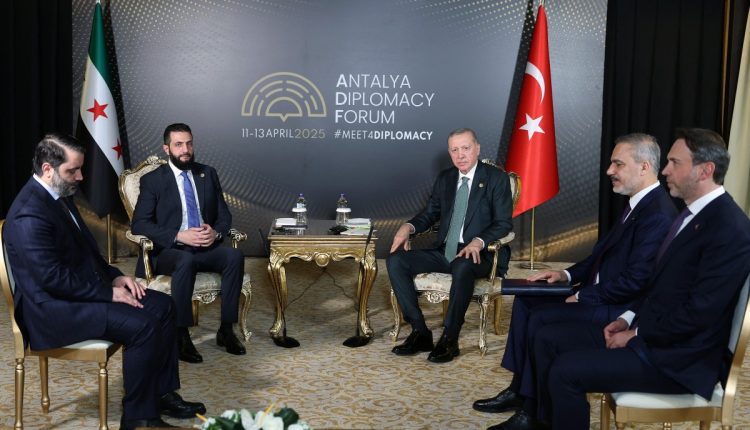Examining the Ideology of Hay’at Tahrir al-Sham: Is a “Deep State” Taking Shape?
By Tariq Hemo
Hay’at Tahrir al-Sham is exercising a significant degree of pragmatism and maneuvering, having transformed—following the “Deterrence of Aggression” operation—from an organization descended from Jabhat al-Nusra into a decisive, interventionist force, and then into a state after culminating its military campaign on December 18, 2024, with a pivotal historical event: the entry into Damascus, both as liberator and controller.
Prior to that, Hay’at Tahrir al-Sham was a jihadist organization that split from “Al-Qaeda,” led by Ayman al-Zawahiri. It engaged in ideological and doctrinal disputes and military confrontations with allied groups, competing for legitimacy and rightful claims. It succeeded in seizing a portion of the land of Syria, specifically Idlib, where it built authority/emirate and focused on consolidation and preparation, all while lying in wait for the opportunity to strike at its rivals, including the Assad regime in Damascus, following a covert strategy that entails starting with the weakest, then the weak, then the strong, and finally the strongest.
The political awareness of the group appeared to be evolving in terms of understanding the Syrian context and the military power map, as well as the influence of the regional and international powers present and active in the Syrian arena. The organization sought to adapt its ideology to align with geographic constants and the nature of societal structures. All of this took place within the framework of a self-transformation from an international jihadist faction into a local revolutionary faction in Sham, and later into a Syrian national faction. These transformations were preliminary for playing a greater role that it aspired to and was poised to practice, which is horizontal expansion, achieving its ambition to roll toward power like a snowball that grows as it rolls forward by attracting larger and larger amounts within itself.
Hay’at Tahrir al-Sham now rules Damascus. During its early days, the group announced its break from Al-Qaeda (to rid itself of religious dependency and guardianship) and fought ISIS (to eliminate a competitor that claimed to apply all of Sharia, not just part of it). It pledged not to “attack the West on its home turf” as other global jihadist organizations do, “to remove the justifications of the international community” in forming a coalition against the group and crushing it militarily. The group consolidated its power in Idlib after imposing itself on all factions and Islamic groups, urging them to join its ranks to establish an Islamic-national front that would serve as the nucleus of the decisive force when the opportunity arises to assault Damascus and topple the Assad regime and seize power. The Idlib experience remained the model that the group and its leader Abu Mohammad al-Jolani (later Ahmed al-Sharaa) used to persuade everyone of their capability to manage the Syrian state, thus exporting this model of governance to all areas of Syrian territory.
Currently, Hay’at Tahrir al-Sham lives the reality of governance and administration in a devastated state emerging from a civil war plagued with the plans and ambitions of neighboring countries. The group, based on its understanding of consolidating influence and empowerment, seems to desire to deal with and undermine the active powers in the Syrian arena, without adequately accounting for the rapid interventions of regional states and factions seeking to delineate areas of influence and control in the Syrian landscape. The organization began to create, absorb, and recycle forces and figures functionally, granting them some space while presenting them as partners and parts of the authority. Entities close to the Turkish state received the largest share of the allocations of “functional groups” that the group created to satisfy Turkey and convey the narrative that it accepts partnership in state management, while reality suggests otherwise. These groups have no decision-making power, and all military, security, economic, and diplomatic matters lie in the hands of a select few close to Ahmed al-Sharaa.
Domestically, the group seeks to create functional groups that are subordinate to it, while presenting itself externally as a functional group capable of satisfying all influential powers in the Syrian scene, thus forming itself according to the required specifications. It commits to fighting terrorism and ISIS, maintaining international agreements made by the previous regime, safeguarding borders, and eliminating Iranian influence. All of this occurs in exchange for granting it legitimacy and a degree of peace to root itself and empower in Syrian territory within a transitional period that it has defined as five full years.
As for political forces, they have no place in the state/emirate of the group. The current reality is entirely built on the narrative of “those who liberate decide,” stemming from the “victory” achieved by Hay’at Tahrir al-Sham in the Syrian civil war. This victory created a new political reality that allowed the group to shape a “new Syria,” much like the victory of allies in World War II granted them the right to shape the United Nations Security Council and enjoy veto power, thus imposing the visions and management style of the victorious upon the entire international scene. Hay’at Tahrir al-Sham seeks to build a state that fits its own interests—a state run by the victors that retains control over all power centers and the institutions and administrations of the “deep state.” In this state, the organization distributes some positions and tasks to individuals of its choosing, evaluating their ethnic, religious, or sectarian backgrounds as a form of “power-sharing,” yet this is a superficial and inverted power-sharing. The group does not accept collective rights but constricts the rights of communities to the crafting, training, and exporting of individuals, which leads to symbolic representation and forgery, evading the real essence of the problem. When it meets with religious leaders, sheikhs, wise men of sects, and local faction leaders, it operates from a perspective that rejects the existing political forces and parties based on the concept of Syrian nationalism. It desires division and fragmentation while linking the “symbols” of these components to power, thereby entrenching its narrow and distorted concept of identity and geographical power sharing.
The group aims to market itself as a state and seeks acceptance from the international community. It wants to lift sanctions on Syria, hold an international conference for reconstruction, and remove all its members from terrorist lists. It seeks to avoid the repercussions of the massacres that occurred along the coast against the Alawite component (it has established an investigative committee that will likely issue a report based on its understanding and perceptions of what happened). The organization struggles to uphold the agreement it made with the Syrian Democratic Forces, which was imposed on it by influential powers with a dominant voice in the Syrian scene. Critics and opponents of Hay’at Tahrir al-Sham argue that it is not serious in accepting others as will and power. They claim that it betrays when it can, and that the agreements and understandings reached are merely a phase of “crisis management.” It is undoubtedly the case that active Syrian parties, whether in the northwest of Syria or in Sweida, have a perception of the nature of Hay’at Tahrir al-Sham and its way of thinking, and thus they recognize the identity of the organization they encounter and negotiate with.
There is an awareness of the thirst for power among Hay’at Tahrir al-Sham and its leaders. The history of the group is well-known, as are its mechanisms for absorbing rivals. Everyone knows that what is currently happening is not an extension of the popular uprising that occurred in March 2011, which called for the crumbling regime to abide by the rule of law, freedoms, and justice, paying a severe price in blood and the wealth of Syrians. Instead, it results from a geopolitical earthquake that took place in the Middle East, centered around Gaza, dated October 7, 2023, and part of the outcome from the destruction of the Israeli state in the context of the “Resistance Axis” was the rise of Hay’at Tahrir al-Sham to power in Damascus and its construction of a victory on which it now bases a complete state, seeking to absorb all the Syrian political and struggle heritage and reduce diversity and plurality to marginal characters it brings forth within the framework of symbolic representation and forgery it currently practices everywhere.
Hay’at Tahrir al-Sham benefits from some Syrian “elites” that strive to promote its policies and will, perceiving this as a “transitional phase” that will conclude with a state of law, citizenship, and institutions, asserting that its empowerment and expansion constitute “the lesser of two evils,” as the alternative is a civil war among components and geographies, and that the group is the one that prevents this war from occurring, thus serving as “the safety valve” of the country! From a national perspective, they assist it in navigating through this “sensitive phase of our nation’s and community’s history,” according to the theoretical ideas and concepts of some of these old/new Syrian elites.




Comments are closed.